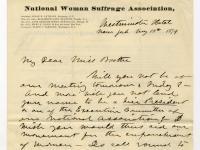This WebQuest is focused on 12th grade historical research. The WebQuest may be used simultaneously with an unit on the women’s suffrage Movement. Students will use their textbook, online historical resources and in-class assignments on the women’s suffrage movement. Prior to students conducting internet research, they should be provided background knowledge of different topics and events during the women’s suffrage movement. In addition to classroom instruction, this WebQuest is an active learning activity that allows students to take part in the lessons and helps them develop an individual perspective on the women’s suffrage movement, as well as gain an understanding of how the movement is relevant to their lives. The WebQuest activity involves students to take on the roles of historians and newspaper journalists. Their newspaper is to be an accurate historical account that illustrates individual perspectives on the movement and its outcomes. The newspaper aims to influence the American public and government to support the passage of an equal voting rights bill.
At the beginning of the Women’s suffrage unit, students should be provided with the WebQuest assignment. The handout will include the description, instructions, library research trail, and the evaluation rubric. Students will create their own women’s suffrage digital or in-class portfolio. The purpose of the portfolio is to help the students organize all their notes and internet sources gathered throughout the Women’s suffrage unit. All of the information will be used to develop and complete their WebQuest research project. There are six step to follow in order for the students to achieve a greater understanding of the women’s suffrage movement:


